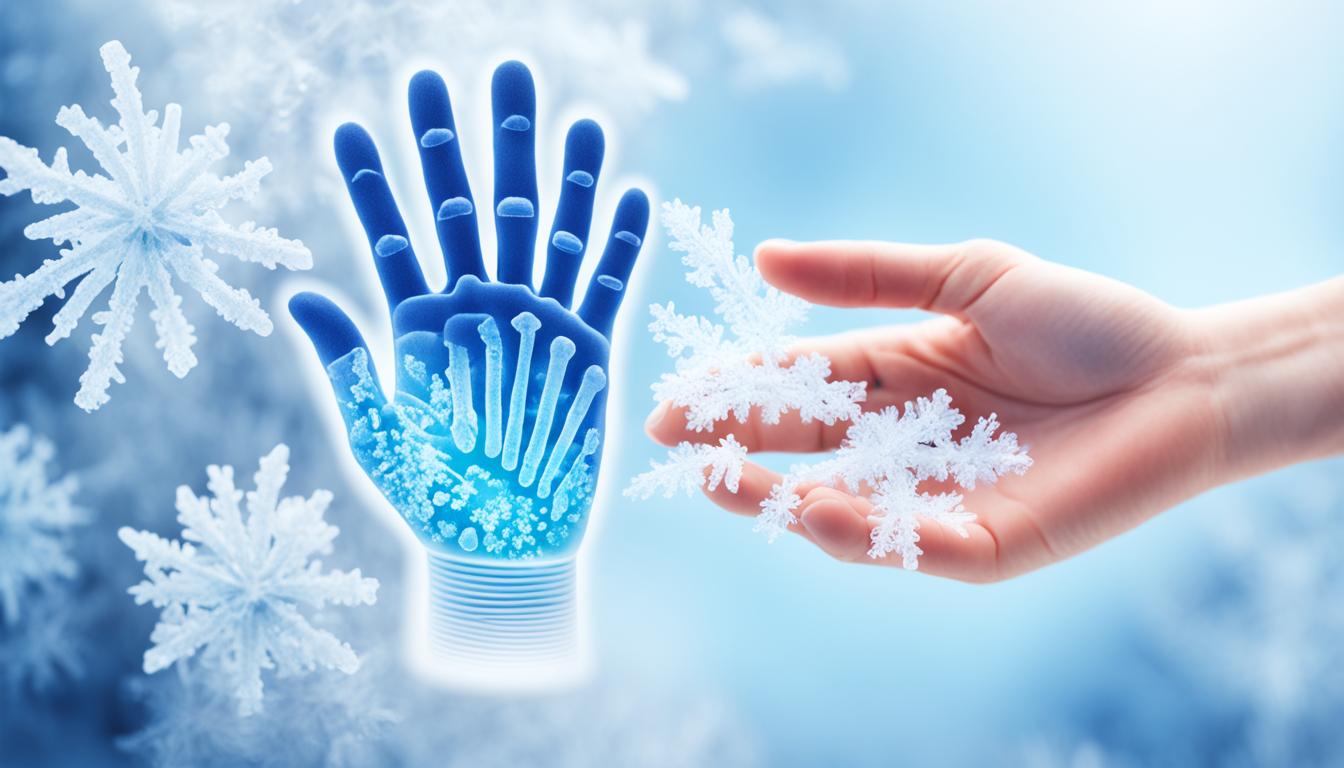Raynaud’s Disease affects small blood vessels, mainly in the fingers and toes. It causes these areas to lose blood flow at times. This makes them change color, feel painful, numb, or tingle. Cold or stress often trigger these episodes, known as Raynaud’s phenomenon.
Stem cell therapy offers hope for people with Raynaud’s Disease. This method uses the healing power of stem cells. It aims to repair blood vessels, ease inflammation, and enhance blood flow. These benefits could reduce symptoms and make life better for those with the condition.
Still, stem cell treatment for Raynaud’s is not widely available. Research and clinical trials are exploring its use. Patients interested in this option should talk with their doctors. They can help weigh the treatment’s possible outcomes and risks.
Key Takeaways:
- Raynaud’s Disease affects blood flow to the extremities, causing color changes, pain, numbness, and tingling.
- Stem cell therapy for Raynaud’s Disease aims to repair blood vessels, reduce inflammation, and improve circulation.
- This therapy shows potential in diminishing the severity and frequency of Raynaud’s symptoms.
- Stem cell therapy for Raynaud’s Disease is still undergoing research and should be discussed with healthcare professionals.
- Consultation with healthcare professionals is crucial for proper diagnosis and management of Raynaud’s Disease.
Understanding Raynaud’s Syndrome and Stem Cell Therapy
Raynaud’s Syndrome causes our hands and feet to lose blood flow at times, making them change color. This often happens when it’s cold or we’re stressed. People typically adjust their life and take medicines to help. But now, more are looking into using stem cells to treat it.
Stem cell therapy aims to help the body heal itself. It can boost blood vessel growth and increase blood flow. So, it might make Raynaud’s attacks occur less and be less severe.
Thinking of trying stem cell therapy for Raynaud’s? Make sure to thoroughly check on where you’re going and who will treat you. The quality of the medical center and the doctor’s experience are vital. They ensure you get the best care and results.
Potential Benefits of Stem Cell Therapy for Raynaud’s Syndrome
- Reduced Frequency and Severity of Attacks: Stem cell therapy has shown promise in decreasing the frequency and severity of Raynaud’s attacks, allowing individuals to experience fewer discomforting episodes.
- Improved Blood Flow: It helps create new blood vessels, aiming to make blood flow better in your hands and feet. This can lower the risk of color changes and the problems they cause.
- Long-lasting Results: It might offer a lasting fix by targeting what truly causes Raynaud’s. This is better than just managing symptoms.
- Minimized Complications: Better blood flow from stem cell therapy might cut the chances of getting ulcers or skin infections due to Raynaud’s.
While the idea of using stem cells for Raynaud’s is exciting, we need more studies to fully trust it. Always talk to your doctor before trying any new treatment. They can help you choose what’s safest and best for you.
Symptoms, Causes, and Types of Raynaud’s Condition
Raynaud’s syndrome mainly affects the fingers and toes. They might turn white, blue, or red. This happens due to changes in blood flow. People with Raynaud’s can also feel numb, tingle, or be very sensitive to cold. This can cause mild to severe discomfort, affecting daily life.
There are two types of Raynaud’s. Primary Raynaud’s Disease occurs alone, with no known cause. Secondary Raynaud’s Syndrome appears with other health issues like scleroderma or lupus. These other diseases can lead to or worsen Raynaud’s.
Cold temperatures and cold regions increase the risk of Raynaud’s. So does exposure to vibrations, repetitive hand movements, or stress. These factors can bring on Raynaud’s.
It’s more common in women and may run in families. Diseases like scleroderma or lupus make secondary Raynaud’s more likely. Smoking or drinking a lot of caffeine can also play a part.
Early diagnosis is key to managing Raynaud’s. Understanding and treating the causes and triggers helps. This can lead to personalized plans that make life better for those with Raynaud’s.
The Future of Stem Cell Therapy for Raynaud’s Disease
The future of stem cell therapy for Raynaud’s Disease is looking up. Ongoing research is finding out how stem cells can help our veins stay healthy. Trials and studies are improving how we use this therapy. By fixing the root issues, stem cell therapy may be a game-changer for those with Raynaud’s.
There’s big hope in regenerative medicine for Raynaud’s Disease. This new area aims to use the body’s own healing to fix problems. Stem cells are key. They can change into different cell types to repair what’s damaged. This might help blood flow like it should in fingers and toes.
Despite its promise, more research is a must for stem cell therapy. It’s vital to check its safety and how well it works for Raynaud’s. Doctors and researchers are working hard to get this info. They’re doing large tests to find the best ways to use this therapy safely. They’re also keen on learning the pros and cons over time. This way, they can keep patients safe.

